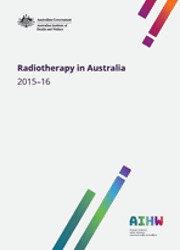In brief
Radiotherapy uses radiation directed at a localised area to kill or damage cancer cells. It is a well-established, effective and safe way to treat cancer and a small number of other conditions. It can be used to treat conditions (curative intent), to prevent them (prophylactic), or to manage or lessen their symptoms (palliative).
Radiotherapy activity
60,600 courses of radiotherapy began in 2015–16.
2 in 3 radiotherapy courses (67%) were delivered in the public sector and 1 in 3 (33%) were delivered in the private sector.
Radiotherapy patients: age and sex
1:1 is the ratio between male and female radiotherapy patients.
1 in 4 males (27%) who received radiotherapy had a principal diagnosis of prostate cancer.
1 in 2 females (47%) who received radiotherapy had a principal diagnosis of breast cancer.
Sex and age
For people aged less than 60 years, more radiotherapy courses are delivered to females, but for those aged over 60, more courses are delivered to males.
7 in 10 radiotherapy courses (70%) were for people aged 60 and over.
Radiotherapy treatment: intent and emergency status
58% of radiotherapy courses were delivered with the intention of curing disease, 38% were palliative and 1% were preventative (prophylactic).
96% of emergency courses (which required treatment within 24 hours) were for palliative care. Emergency courses made up 2% of all radiotherapy courses.
Patient age and intention of treatment
Younger patients are more likely to be treated with curative intent than older patients, and the older a patient is, the more likely they are to be treated with palliative intent.
Emergency status and intent of treatment
2% of radiotherapy courses were emergency cases, where the patient should receive treatment within 24 hours. The majority of emergency cases were for palliative care. The majority of non-emergency cases were aimed at curing disease.
Radiotherapy waiting times
The 2015–16 collection included data about waiting times for treatment. Waiting times are measured from when the patient is 'ready for care' to the beginning of the course of treatment.
More information about how waiting times are measured is available in Radiotherapy in Australia 2015–16.
9 days was the time within which 50% of patients started radiotherapy; 90% started within 27 days; 10% waited longer than this.
14 days was the time within which 50% of patients receiving radiotherapy with the intention to cure disease started radiotherapy; 90% started within 29 days; 10% waited longer than this.
6 days was the time within which 50% of patients receiving radiotherapy with the intention of palliation started radiotherapy; 90% started within 19 days; 10% waited longer than this.
9 in 10 patients (91%) who received emergency radiotherapy started treatment the same day or the next day.
Data notes
Data on this page are from the first year of the Radiotherapy Waiting Times National Minimum Data Set that started in 2015–16 and the waiting times for those treatments. All public radiotherapy providers in Australia reported data, along with a high proportion of private sites.
The data on this page are for megavoltage external beam radiotherapy delivered by linear accelerator machines.



